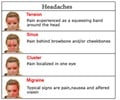Biological basis of migraine could now be understood better as a groundbreaking study helps identify more than 120 regions of the genome associated with migraine risk.

TOP INSIGHT
Biological basis of migraine and its subtypes could now be understood better as a groundbreaking study helps identify more than 120 regions of the genome associated with migraine risk.
The study involved leading migraine research groups in Europe, Australia, and the United States working together to pool genetic data from more than 873,000 study participants, 102,000 of whom had migraine.
The new findings, published in the journal Nature Genetics, also uncovered more of the genetic architecture of migraine subtypes than was previously known.
Neurovascular mechanisms underlie migraine pathophysiology
Migraine is a very common brain disorder with over a billion patients worldwide. The exact cause of migraine is unknown, but it is believed to be a neurovascular disorder with disease mechanisms both within the brain and the blood vessels of the head.
To gain more insight into the specific risk genes, researchers from the International Headache Genetics Consortium assembled a large genetic dataset to conduct a genome-wide association study (GWAS), looking for genetic variants that were more common in those who had migraine in general, or one of the two main migraine types.
“In addition to implicating tens of new regions of the genome for more targeted investigation, our study provides the first meaningful opportunity to evaluate shared and distinct genetic components in the two main migraine subtypes”, said the first author of the study, Heidi Hautakangas from the Institute for Molecular Medicine Finland, University of Helsinki.
Furthermore, the results supported the concept that migraine is brought about by both neuronal and vascular genetic factors, strengthening the view that migraine truly is a neurovascular disorder.
Potential to point to new therapies against migraine
As migraine is globally the second largest contributor to years lived with disability, there is clearly a large need for new treatments.
A particularly interesting finding was the identification of genomic risk regions containing genes that encode targets for recently developed migraine-specific therapeutics.
One of the newly identified regions contains genes (CALCA/CALCB) encoding calcitonin gene-related peptide, a molecule involved in migraine attacks and blocked by the recently introduced CGRP inhibitor migraine medications. Another risk region covers the HTR1F gene encoding serotonin 1F receptor, also a target for new migraine-specific medications.
Dr. Matti Pirinen, a group leader from the Institute for Molecular Medicine Finland, University of Helsinki, who led the study, commented: “These two new associations near genes that are already targeted by effective migraine drugs suggest that there could be other potential drug targets among the new genomic regions, and provide a clear rationale for future genetic studies with even larger sample sizes.”
The study was a joint effort between research groups from Australia, Denmark, Estonia, Finland, Germany, Iceland, Netherlands, Norway, Sweden, UK, and the USA.
Source-Eurekalert
 MEDINDIA
MEDINDIA



 Email
Email







